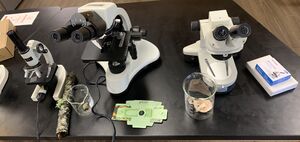Research has shown that fungal mycelium can effectively remediate harmful chemical compounds.
What are the goals of the project?[edit | edit source]
A design for an accessible mycoremediation program that empowers people to engage in scientific research, grow their knowledge of bioremediation, and add their voice and cultural knowledge to curriculum development. Additionally, our goal is for the open-sourced curriculum to be adaptable for use in a range of educational spaces. We aim to use locally-sourced biological materials for the toxin absorbing myco-filter socks, such as an invasive, fire-prone plants as the substrate to grow a fungal mycelium.
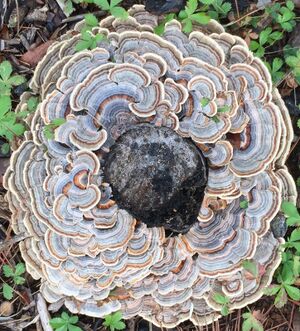
To design a simple, low cost, and standardized protocol for effectively growing locally-sourced mushroom mycelium on invasive species plants for use in classroom experiments exploring myco-filter sock mycoremediation.
Materials Needed[edit | edit source]
Sock material (eg. burlap, hessian, Filtrexx SiltSoxx® NATURAL PLUS+) for filling with spawn and substrate;
Fabric shears to cut the sock material to size and create ties;
Mushroom spawn from a local wood-decomposing fungal species (eg. Pleurotus spp., Trametes spp., etc.);
Woody substrate (eg. wood chips from a recently-cut invasive tree species) to serve as food for the mushroom mycelium;
Non-chlorinated water;
Gloves to protect hands;
Storage totes for mixing spawn and substrate;
Pollutant (dirty water, water with dish soap, used motor oil, etc.);
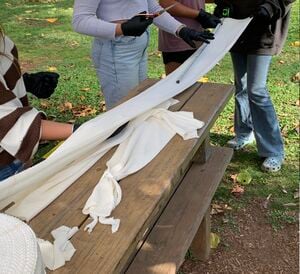
Tables to elevate experiment;
Concrete mixing tubs to conduct experiment inside;
Two-by-four that is two feet long;
Drill and drill bits to a drill hole in the concrete mixing tub;
Buckets to simulate a rain event and to catch simulated storm water runoff;
Jars with lids for collecting water samples;
Masking tape for labeling;
Permanent markers for labeling;
Measuring stick;
Microscope slides and cover slips;
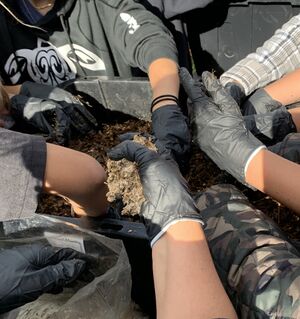
Microscope.
Creating Myco-Filter Socks[edit | edit source]
Cut one inch strips off sock material to create ties.
Fill sock material with mixed woody substrate and tie off the ends of the filter socks.
Soak finished filter socks with non-chlorinated water until moist but not overly soggy.
This filter sock will be the control for the mycoremediation experiment as it was not inoculated with mushroom mycelium.
Wearing gloves, add woody substrate and mushroom spawn at a 10:1 ratio into a storage tote so that the mushroom spawn makes up 10% of the total volume. Mix woody substrate and mushroom spawn by hand in the storage tote until completely homogenized.
Cut one inch strips off sock material to create ties.
Fill sock material with mixed woody substrate and mushroom mycelium and tie off the ends of the myco-filter socks.
Soak finished myco-filter socks with non-chlorinated water until moist but not overly soggy.
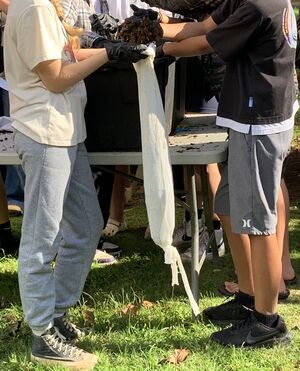
Place myco-filter sock in a shady area off the ground and allow it to myceliate for two-to-four weeks.
Preparing Mycofiltration Experiment[edit | edit source]
Drill a 13 millimeter hole into one of the bottom sides of the concrete mixing tub and place on top of the table.
Place one of the two-by-fours below the concrete mixing tub on the side opposite the drilled hole so that water will drain down towards the drilled hole.
Place a bucket onto the ground below the drilled hole to catch the excess simulated rainwater runoff.
Tear off strips of masking tape and tape them to the glass jars.
Label jars accordingly: "unfiltered water" for water samples taken before the polluted water is passed through the myco-filter sock, "filtered water" for water samples taken after the polluted water is passed through the myco-filter sock, and "unfiltered control" for water samples taken before the polluted water is passed through the control filter sock, and "filtered control" for water samples taken after the polluted water is passed through the control filter sock.
After the myco-filter sock has finished myceliating (two to four weeks after inoculation), precisely position the myco-filter sock over the hole in the concrete mixing tub.
Test: Simulated Dirty Stormwater Runoff Event[edit | edit source]
Mix pollutant (eg. dirt, dish soap, used motor oil, etc.) with water in the bucket.
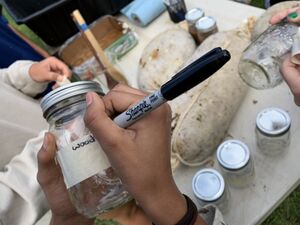
Collect a baseline sample of polluted water in the jar labeled "unfiltered water".
Hold or carefully place a jar below the hole that has been drilled in the lowered side of the concrete mixing tub.
Slowly pour polluted water into the side of the concrete mixing tub elevated by the two-by-four so that the water runs into the myco-filter sock and has to pass through it as a filter before exiting out of the drilled hole and into the collection jar.
Repeat all of the above steps with the control filter sock which was not inoculated with mushroom mycelium and collect the baseline and filtered water into the appropriate labeled jars for the control sock.
Screw the jar lids onto all of the jars and let sit undisturbed for 48 hours.
Test Results[edit | edit source]
Allow 48 hours for the pollutants to settle to the bottom of the jars.
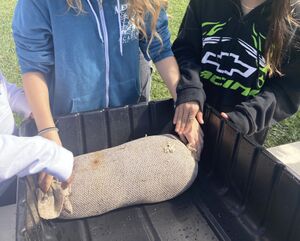
Use a measuring stick to measure the height of the pollutant sedimentation in the bottom of each jars to measure filtration results.
Shake jars to homogenize polluted water and use a pipette to extract a polluted water sample from each jar.
Place a drop of polluted water onto a microscope slide, add cover slip and inspect under the microscope.
Count how many particulates and microorganisms are in each sample from each jar and compare.
Repeat for each and every jar of polluted water.
Citations:
Nahid Akhtar, M. Amin-ul Mannan, Mycoremediation: Expunging environmental pollutants,
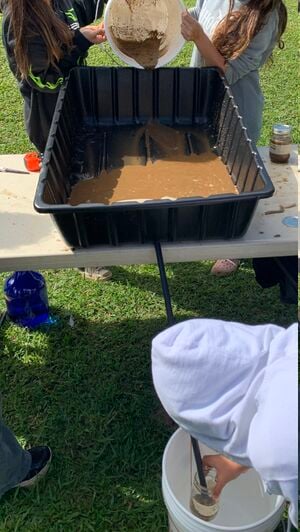
Biotechnology Reports, Volume 26, 2020, e00452, ISSN 2215-017X, https://doi.org/10.1016/j.btre.2020.e00452.
Maui Silt-Sock Mycoremediation Experiment Program. David Pollmiller, et al. DOI: 10.18258/54751
Sieber A, Jelic LR, Kremser K and Guebitz GM (2024), Spent brewer’s yeast as a selective biosorbent for metal recovery from polymetallic waste streams. Front. Bioeng. Biotechnol. 12:1345112. doi: 10.3389/fbioe.2024.1345112
Elisabetta Loffredo , Giancarlo Castellana , Andreina Traversa & Nicola Senesi (2013) Comparative assessment of three ligninolytic fungi for removal of phenolic endocrine disruptors from freshwaters and sediments, Environmental Technology, 34:12, 1601-1608, DOI: 10.1080/09593330.2012.760654
